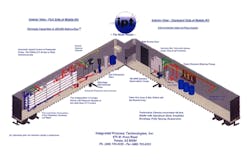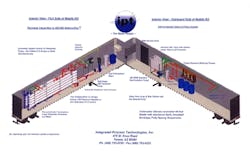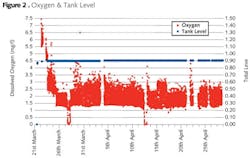Improving Plant Performance with RO Data Normalization
By Miller Truby and Warren Casey
Effective operation and maintenance of a reverse osmosis water treatment plant often revolves around the ability of administrators and key personnel to make informed decisions in a timely manner. RO membrane systems have long relied upon data ‘normalization’ to simplify raw operational data into meaningful and accurate trends. Normalization – as it relates to RO systems – is simply the analysis of data in a way that removes potentially confusing conflicts between constantly evolving variables. A plant operator must be able to quickly determine whether or not a change in the operational profile of his or her plant is expected. This can be a difficult task as there are often several interrelated variables and they may all be changing at once.
Figure 1: This graph shows the overall Normalized Permeate Flow for Train 4, along with a line indicating a necessary cleaning. Since the graph of the NPF has not dropped below the cleaning line, it can be surmised that this train does not need to be cleaned based on flow at this time.
Traditional normalization programs have generally taken the form of basic spreadsheets with embedded macros. They have been offered by membrane manufacturers to the users of RO membranes for at least a decade. Unfortunately these normalization routines were often cumbersome and limited, making it difficult to pinpoint the problems they were intended to help solve. Data was necessarily entered by hand (a potentially time-consuming chore), graphing or trending capabilities were severely lacking, and the email distribution of the final results to key parties was prohibitive due to the large file size of the macro-laden spreadsheets. Nothing about these older programs was automatic or intuitive and in the worst cases they became more trouble than they were worth.
The new age of complex SCADA systems and PLC controllers has resulted in the necessary modernization of normalization software for RO systems. It is in the best interests of a given utility for a membrane manufacturer’s normalization program to be capable of securely acquiring data directly from the SCADA system, or from a “historian” server being fed by the SCADA system. The normalization software should then be able to produce a clear trend (or set of trends) containing pertinent information with minimal input from the operator. To accomplish this, membrane manufacturers have been forced to upgrade from the tried-and-true but highly limited method of spreadsheet-based programs.
To that end, reverse osmosis membrane manufacturer Toray has spent several years developing its TorayTrak™ normalization software. It is built in the visual basic programming language and acts as a stand-alone piece of software. Operational data from an RO system can be input through a variety of methods, including direct input from a SCADA system; fully manual input via a data entry screen; multiple-data-point import from a spreadsheet; or any combination of these methods.
For example, an RO system that is not fully instrumented might be set up to send data directly from their SCADA system to the software. An operator could then fill in the missing information by hand, completing the data point.
The program includes a graphical interface that automatically generates graphs of up to 52 parameters. Up to four of these parameters can be combined on a single graph at the user’s discretion to create custom graphs that can then be saved by the operator. These graphing features are a major highlight of the program because they allow anyone with an interest in the RO system in question to identify potential problems. It is important to note that while most plants operating with SCADA systems have the capability to graph raw data directly on the HMI interface, this data is usually not normalized and can be misleading.
Because the software requires little effort to install and set up, operators can begin to collect and normalize data immediately at plant start-up — a critical time in the life of an RO system. The following case studies provide examples of RO plants successfully using the software to monitor daily operation and to diagnose and avoid potential problems.
Eastern Australia
The RO portion of an 18.5 MGD wastewater reclamation system located in Eastern Australia contains four distinct trains. Each train is divided into three stages in a 120-60-30 array. The 210 seven-element pressure vessels in each train contain a total of 1,470 Toray TML20-400 membranes, making for a grand total of 5,880 wastewater membranes installed at the site. Feed water for the site comes from a local sewage treatment plant.
It was apparent from the very first day of commissioning in late 2008 that data monitoring at this site was going to be of the utmost importance to the plant’s success. The feed water to the system — which passes through a microfiltration step before being fed to the RO trains — can vary from 1,500 µS/cm to above 4,000 µS/cm. The temperature of the feedwater also varies seasonally and ranges from about 21ºC up to 31ºC.
Because of these variations, and because the plant is treating wastewater with a high fouling potential, normalization of the operating data was a requirement. The site is fully instrumented, which is very important for a three-bank system, and operating data is taken from the SCADA system and placed on a spreadsheet for distribution to interested parties. Toray Membrane USA receives this data and imports it into the normalization software where it can then be graphed and interpreted (see Figs. 1-2).
Figure 2: This graph shows the Normalized Permeate Flow only for the third stage of Train 4. Though the system did not need to be cleaned overall, it is clear that stage 3 does need to be cleaned based on flow. You can see that after the cleaning occurred, the normalized permeate flow in stage 3 returned to start-up values, indicating that the cleaning was successful.
Florida, USA
An RO system located on the east coast of Florida in the United States treats well water from the Floridan aquifer to create 20 MGD of potable water for the surrounding community. The plant consists of ten RO units, eight of which have Toray membranes installed in them while the remaining two contain another manufacturer’s membranes.
This system is particularly notable because the software was set up to acquire most of the operating data from a secure connection to the SCADA historian, while the small amount of critical data that must be measured with handheld instruments — such as individual bank permeate conductivities — is manually entered. As an added benefit, the two trains that contain membranes from a different manufacturer can still be accurately monitored using TorayTrak by entering custom element characteristics into the program.
To increase customizability for the user, a spreadsheet will be set up in the near future to perform additional calculations to evaluate the energy efficiency of each RO unit. These values will be imported into the software by setting up user-defined fields within the program’s “Custom Data Fields” feature. Just as with the regular operating data, custom data fields can be graphed, which will allow plant managers to monitor the energy efficiency of their RO system.
The software has provided insights into the operation of this plant that would not have been available from a generic normalization spreadsheet. The most significant finding has been that there has been no increase in salt passage during the varied life of the membrane (some units have been running over five years while others have only recently come online). This particular piece of information will allow consulting engineers access to reliable historical data when writing specifications to obtain competitive bids for future plant expansions.
About the Authors:
Miller Truby has been a part of the membrane desalination industry for 6 years and has been at his current position with Toray Membrane USA, Inc. for the past 4 years. He is a member of several industry organizations and is currently assisting with the administration of the IDA Young Leaders Program.
Warren Casey is the Technical Service Manager for Toray Membrane USA and has over 30 years of experience in the RO industry as an applications engineer, equipment designer, field service and startup engineer, project manager, and consultant. He has been responsible for the startup of some of the largest municipal RO systems in the U.S. and is also an expert in troubleshooting municipal and industrial RO systems.


